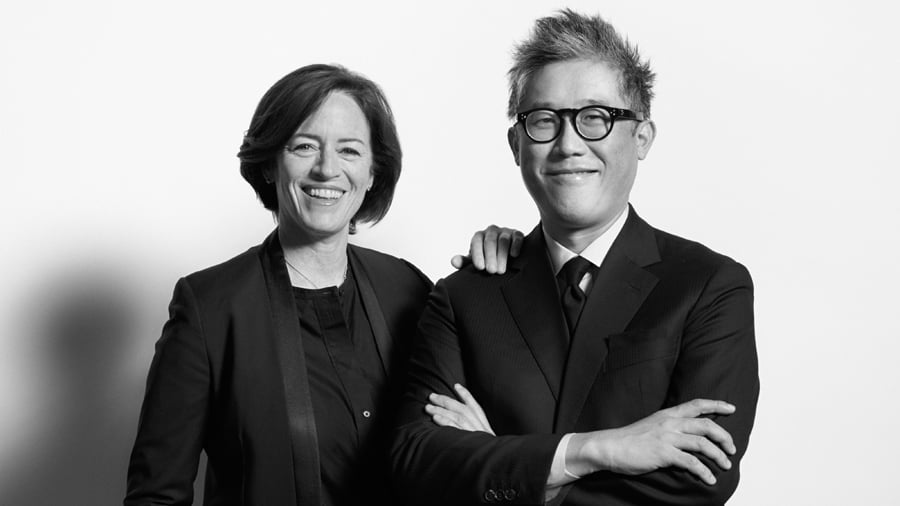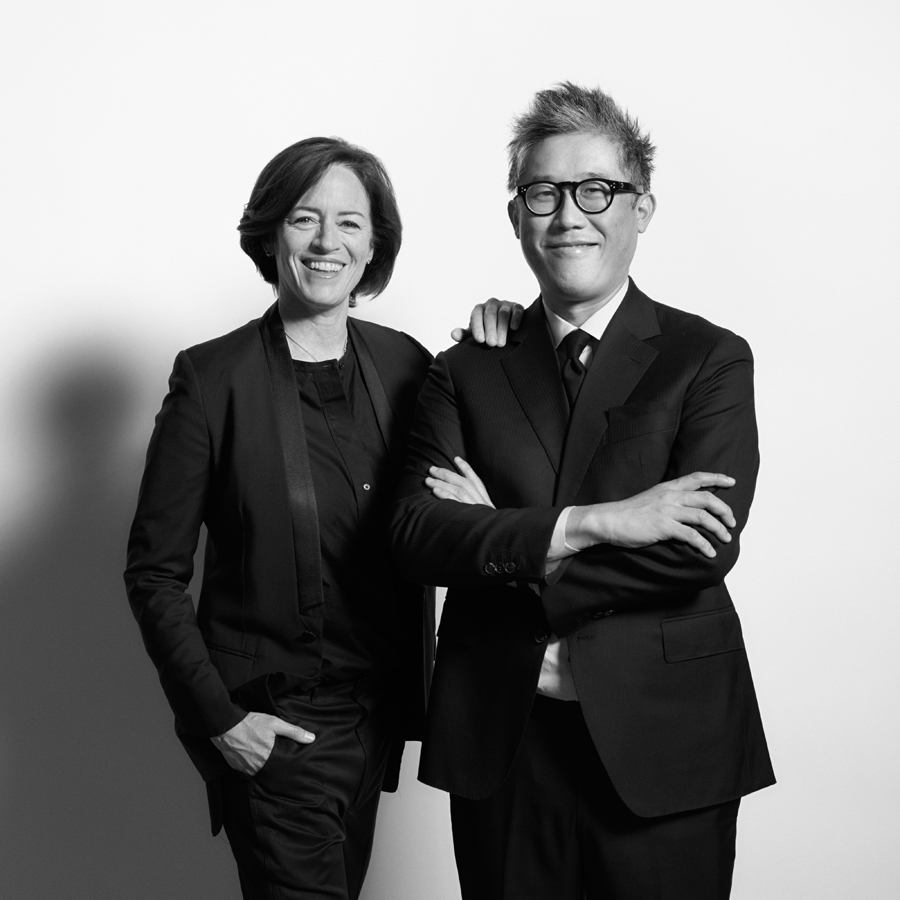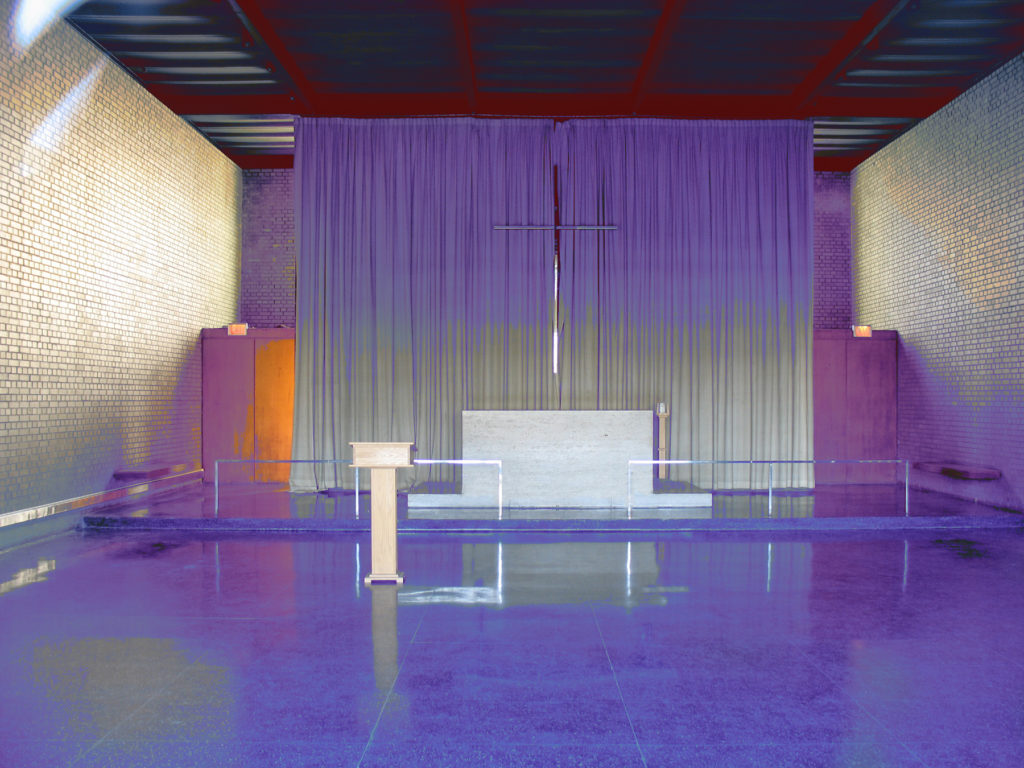
April 6, 2017
Johnston Marklee Says Its Time for Architects to Rediscover Architecture
As curators of this year’s Chicago Architecture Biennial, Sharon Johnston and Mark Lee are prompting participants to look back at the discipline’s history.

It was always the case that the Chicago Architecture Biennial needed more than visitors—530,000 passed through the Chicago Cultural Center, the show’s main venue, in the first go-around—to cement its standing. The launch of the program’s follow-up, titled “Make New History,” accomplishes that while adding a few new features to the mix. (With more than 100 participating architecture practices and artists, the scope remains sweeping.) Metropolis editor Samuel Medina spoke to curators Sharon Johnston and Mark Lee of the architecture firm Johnston Marklee about new exhibition formats, the virtues of Postmodernism, and returning to disciplinary first principles.
Samuel Medina: How do you see this second iteration of the biennial in relation to the first? How did it inform the thematic structure of yours?
Mark Lee: In many ways the first iteration was a cross section of what was happening around the world. An analogy we often use is that it was like going to a restaurant and trying the tasting menu, sampling many different things. And then on your second visit you could focus on just one type of cuisine, and the third time something else. We noticed a lot of “soft” themes that came out through these “meals” or “courses.” It’s actually how we came up with “Make New History.” We hope that in the same way these different subthemes and entry points lead out from it.
SM: Was there anything that you tried fixing or enhancing from the first biennial?
ML: The Chicago Cultural Center is an incredibly complex environment in which to create an exhibition. It’s something of a coherent collection of rooms. We wanted to try to taxonomize these rooms in a way that would create a little bit of order based on location. So we began to think about exhibition types and spatial orders—the salon, arcade, labyrinth, hypostyle hall—that might create coherence and strategically help us organize work in different ways. The salon is a more ad hoc approach; it allows for the integration of disparate things but in a kind of loose way. By contrast, the idea of the labyrinth is a model based much more on movement and on creating spatial “boundaries” that, in the context of an exhibition, allow for different trajectories and connections between projects. We wanted to put on our architect hats.
SM: You designed the “hypostyle hall” for something special, something very “Chicago,” right? You’re re-creating a very important episode from Chicago’s Modernist history.
ML: Yes, that’s where we will display models from 16 architects for a new Tribune Tower. Each of the models will form the “columns” of the hypostyle hall. They will be set at 1/2″ = 1′ scale—16 feet tall—so you will have to look up at them. You will experience the sensation of being in architecture, or at least something that’s more visceral than a typical exhibition experience. There is always this issue of representing architecture, and so we think it will be very different from looking down at a drawing or towering over a model.
SM: The Tribune Tower competition was also given a Postmodernist gloss by Stanley Tigerman and others in the late ’70s. What do you make of the current Pomo resurgence?
ML: There are a lot of good things about Postmodernism that talk to the whole issue of impulsivity. We’re not facing the orthodoxy of Late Modernism that the Postmodernists were reacting against, and so the term becomes much more inclusive now. I hope that people begin to see Postmodernism not just as its American strain, but also the Tendenza and Neorationalists.

SM: We’re getting into familiar territory, but can you tell me what exactly you mean by “history,” or the making of it? It seems that architects tend to instrumentalize history too eagerly. For example, it may simply mean precedent studies.
ML: We see history really as something that is neutral. It’s neither positive or negative in the way our predecessors thought. We don’t see history as something that one is subjected to or something that has to be reacted against, as happened with Modernism. Nor is it something that you have to latch onto, like the architects of previous generations were doing with Postmodernism. Instead, we see history as being intelligence accrued over time.
There’s a tyranny of history, but there’s also a tyranny of the new. We feel that the generation of architects who are practicing today have a renewed understanding of and interest in history that doesn’t have the baggage of previous generations. So history is something of a new slate. Furthermore, we feel this is a time where information and images are readily available, when there is such an abundance of information and images that it has developed into a historical state. Everything is the same and everything is equal; everything is about now. Bringing back this understanding of history and the understanding of lineage—of where things come from—is important to think of where we’re going.
SM: One of the themes buried in your curatorial statement is the possibility of an architecture collective, of architects working together toward a clearly (or narrowly) defined goal. You have mentioned Team X and the Tendenza in Venice before, but there are other examples. Do you think it’s possible—or useful—to pursue this strategy today?
Sharon Johnston: It’s hard to say if this is purely a generational thing. We’ve navigated this in our own office in two ways. One is that around ten years ago we began working on a number of collective projects. It wasn’t like we were working together on one project, but where a number of architects were working on projects independently but still part of a group. That was important initially because we just got to know each other. We were open to exchange and continue to be.
Then we had the chance to even curate different projects and exhibitions. We’ve also been working on the Solo Houses project in Spain, which consists of several houses designed by different architects but all curated and developed by a single organization.
SM: You were involved in designing a pavilion for last year’s Lisbon Architecture Triennale, which was a something of a tag-team effort, right?
SJ: Yes. These are all good examples of maintaining autonomy but bringing different ideas together to sort of develop something new that embodies the shared interests of everybody involved. That’s important. By putting these architects and projects together in the biennial we hope to create new collaborators.
SM: Last year saw an incredible density of architectural exhibitions. There was Venice, Lisbon, Oslo, Istanbul. Several took a very expanded view of architecture and what it means to be a practicing architect today. How did this context help shape your biennial plans?
ML: Well, we share something with the Lisbon Triennale [theme: “The Form of Form”], whose curators were responding to a previous triennial that was about everything but architecture. In a way we are doing something similar by returning to the discipline. Paul Theroux said that travel is only glamorous in retrospect. Over the last 20 years architecture has been moving outside of architecture. But more architects today are saying, “OK, all this travel is good, but can we go back and look at what architecture does best and what nothing else can do?”
I feel there’s an urgency to this question. I don’t think that the response needs to be radical in the way it was in the ’60s. But there’s something healthy about saying in a measured way, “OK, we’ve traveled enough. Let’s look back.”

Recent Viewpoints
Viewpoints
Navigating the Path to Net Zero





